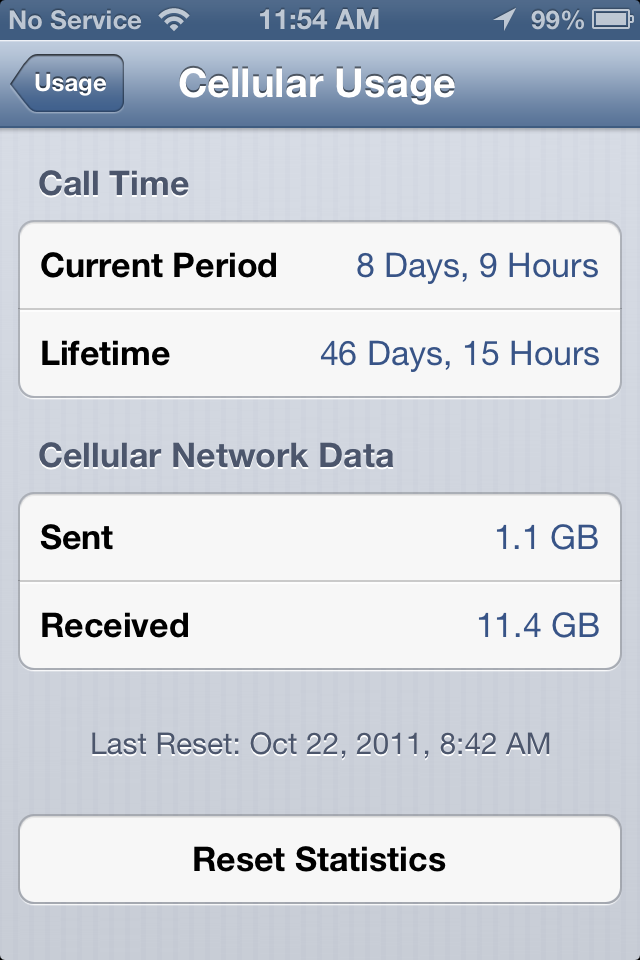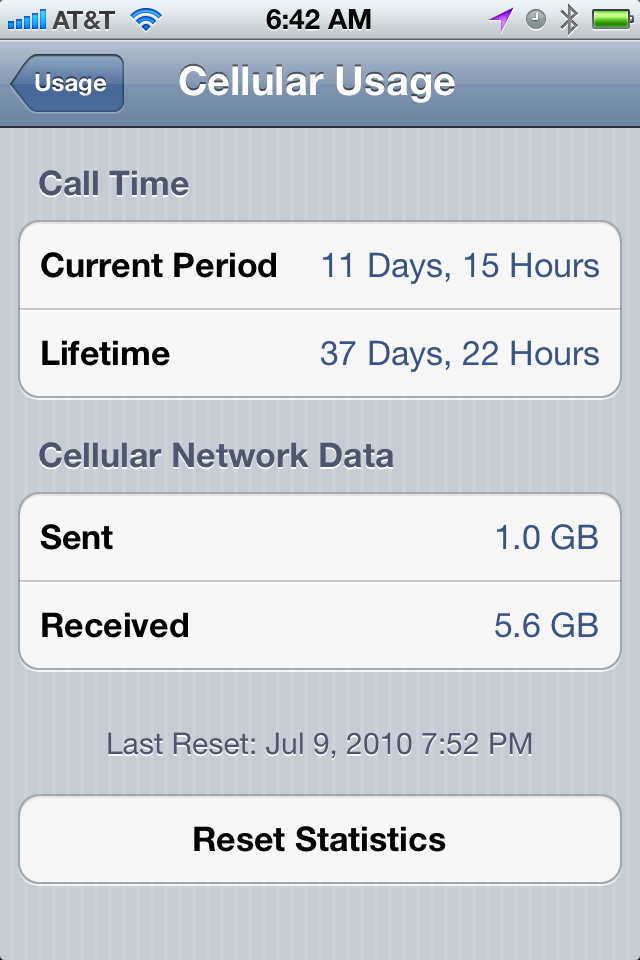AT&T
iPhone 4S Cellular Usage Stats

My iPhone 4S cellular data usage stats from October 22, 2011 to September 22, 2012.
I used 11.4 GB of data in 336 days, or about 34 MB/day. For comparison, I used about 14 MB/day on my iPhone 4.
This continues the trend of increasing data usage with each new device, but the jump from the 4 to the 4S is the largest jump I’ve seen so far (2.4x increase in daily usage). I would attribute the large increase do to my the amount of traveling I did this year. Without WiFi, I relied on my phone quite a bit, especially in countries where tethering was allowed.
See here for my iPhone 4 data usage.
See here for my 3GS data usage.
See here for my 3G data usage.
See here for my original iPhone data usage.
iPhone 4 Cellular Usage Stats

My iPhone 4’s usage stats from July 9, 2010 to October 12, 2011.
I used 5.6 GB in 410 days (460 days minus 50 days spent out of the country for work), or about 13.6 MB/day. For comparison, my iPhone 3GS used 3.1 GB in 381 days, or 8.13 MB/day.
It’s not quite the doubling I saw when going from 1st Gen to 3G or 3G to 3GS, something I would attribute to iOS 5, which I’ve been running since the early summer. I always had WiFi off prior to iOS 5, but with the new wireless syncing feature, I am using WiFi exclusively at home and at work and only dropping down to 3G when I’m not at either.
In contrast, I got my 4S Saturday morning and was out of town until Sunday afternoon. The usage counter on the 4S reads 53.4 MB, or about 25.7 MB/day.
See here for my 3GS data usage.
See here for my 3G data usage.
See here for my original iPhone data usage.
The iPhone 4S Upgrade Conundrum
Ben Brooks has a post up describing the situation most of us are in: despite being loyal AT&T customers for at least the past four years (thirteen years in my case), we aren’t eligible for the full discount on the new iPhone 4S.
Instead, AT&T offers a smaller subsidy for those close to the full discount date, but not quite there yet. Ben, along with most people who bought their iPhone 4s on Day 1, aren’t eligible until November 18th. In my case, I’m not eligible until March 10, 2012 as a result of family members having used upgrades recently. If you have upgrades available on other lines in your family plan, the upgrades are pooled and can be used for a phone on any line, so you can use one of those to get your shiny new iPhone 4S and you can stop reading now if you want.
PAYING THE ETF
The full subsidy for an iPhone 4S is $450 and the smaller subsidy is $200. For a lot of people, the early termination fee of $325 minus $10 for every month you’ve been under contract is less than the difference between the two subsidies, meaning that it makes more sense to pay the ETF and start a new contract with AT&T. Unfortunately, AT&T has policies in place to prevent this from being an option. First, there is no way to pay the ETF without canceling your account. Second, if you do cancel your account, you have to wait 90 days until you’re considered a new customer. If you open a new account before the 90 days have elapsed, AT&T will just reactivate your old account.
GOING UNLOCKED
Since the small subsidy is only $200, one might be tempted to just pay the no-commitment price for the iPhone 4S and save the upgrade for the next iPhone. For the iPhone 4, the unlocked price and the no-commitment-but-locked-to-AT&T price are the same, so it made more sense to buy the unlocked iPhone. I tried to see if the same is true for the iPhone 4S, but I couldn’t find the pricing for the unlocked iPhone 4S. I started a chat with an Apple rep who told me that there would be no unlocked iPhone 4S at launch.
OUR OPTIONS
Now that Sprint is joining the fray and Verizon has the iPhone 4S at launch, it’s curious that AT&T is going to such great lengths to inconvenience their customers. Taking a longer-term view of things, and assuming that the iPhone 5 pricing will leave us in the same boat, here are the options available to us (these are numbers for 16 GB models; add $200 for two 32 GB models or $400 for two 64 GB models):
- $640 - Switch to Sprint or Verizon, then switch to the other or back to AT&T for the iPhone 5 and paying a $240 ETF. Probably not worth it.
- $650 - Switch to Sprint or Verizon and get half-subsidy pricing on the iPhone 5.
- $850 - Pay no-commitment pricing, and then get the full-subsidy for the iPhone 5.
- $900 - Pay the half-subsidy pricing, re-up for two years, and then get the half-subsidy pricing again on the iPhone 5.